Predictions
The Art of Mammarism
Having recently posted about the art of knee reading, here's something along similar lines, though involving a different body part. Patrick Cullen claimed to be a "chest clairvoyant." By examining a woman's breasts, he claimed, he could predict her future. He called this the art of Mammarism. Some details:The technique — perfected, he boasted in the brothels of Shanghai during a 26-year career in the army — involving daubing the breasts in poster colours with a long camel-hair brush. The breast was then pressed against a sheet of paper to achieve a life-size imprint... After studying the prints — and sometimes the breasts themselves — Mr. Cullen would predict the future.
Unfortunately, I haven't been able to find a photo of Cullen at work — nor any photo of Cullen at all.
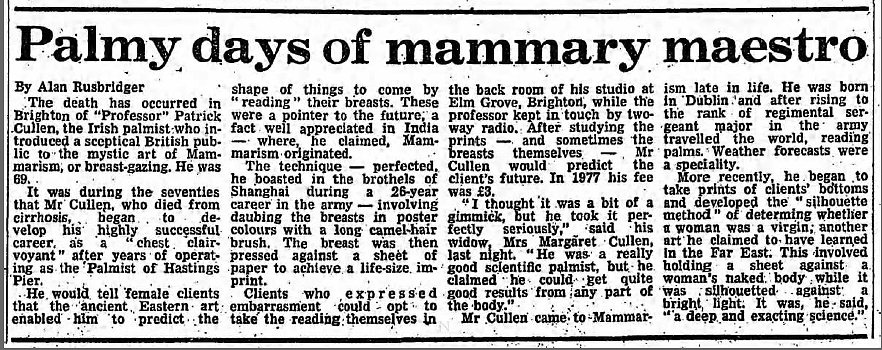
The Guardian - Dec 5, 1980
(click to enlarge)
Posted By: Alex - Tue Feb 19, 2019 -
Comments (1)
Category: Predictions
Knee Reading
Toni Lockhart, aka Gypsy Rose Knee, pioneered the art of knee reading. She detailed her technique in her 1975 book Gypsy's Basic Knee Reader. A few pointers:A new mole may indicate that the person’s life and profession are on the upswing.
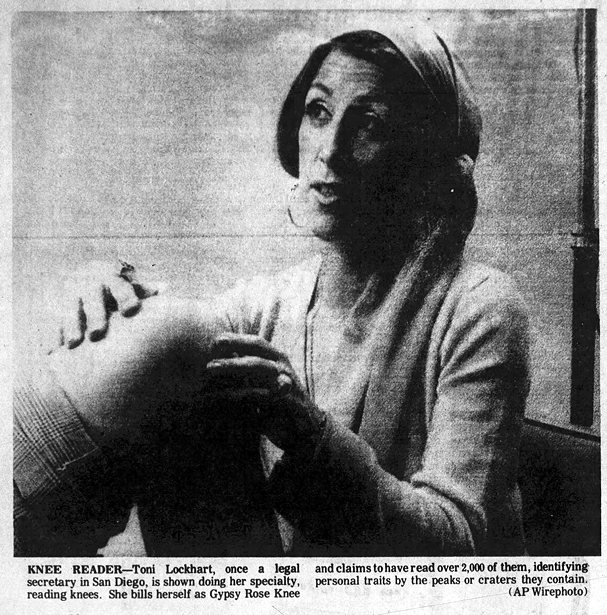
Manhattan Mercury - Aug 8, 1975
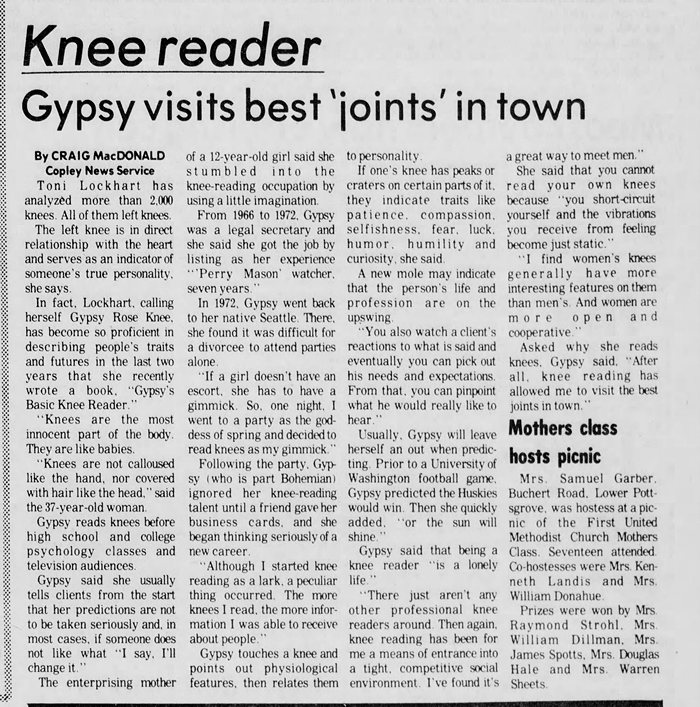
The Pottstown Mercury - Aug 19, 1975 (click to enlarge)
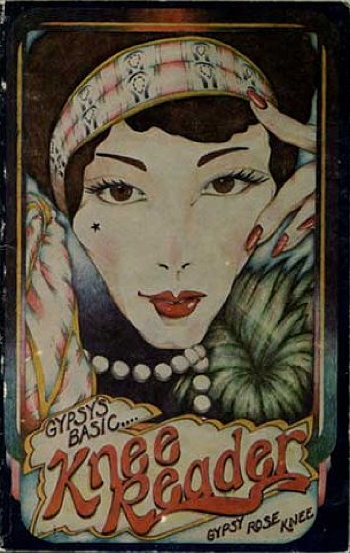
Posted By: Alex - Thu Feb 14, 2019 -
Comments (2)
Category: Predictions, 1970s
Fashion predictions for 2019 - from 1969
Back in 1969, fashion designer Bonnie Cashin offered both a pessimistic and optimistic prediction for how people would be dressing in 2019. I'm guessing her illustration is supposed to show the optimistic one.The pessimistic prediction:
Then each of us may have to wear an environmental covering just to survive. This would be a kind of life-preserving incubator which we would be put into at birth, never to leave. This would serve as an individual habitat. There might be no private homes as we know them. Communities of people would be "stored" for sleeping in giant, multi-level containers, probably according to income level.
In this gear, perhaps called an "environmode," there would be an oxygen system, a speaker system and other devices to maintain bodily functions and self-protection. It would be made of some still-to-be-invented material which articulates with movements of the body. It would have to be close-fitting, but it might be very light and transparent. Underneath would be worn a second-skin garment. In this, the individual might be able to express some personal taste in the choice of color and texture.
The fashion market as we know it would become extinct. A market for new kinds of accessories would come into being, individuality being possible in headgear, oxygen bag, the kind of ray gun you carry and such.
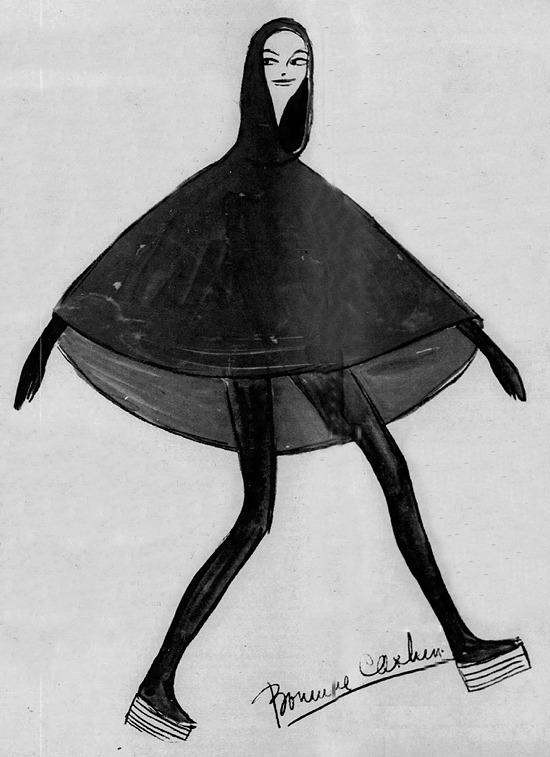
New York Sunday News, Coloroto Magazine - Sep 7, 1969
The optimistic one:
The young will no longer need to look at the world through a rear-view mirror, dressing as Edwardians or gypsies or biblical characters to make their point. They will be too busy planning ahead. They will look at their bodies with pride, conducting themselves with grace.
The "in" four-letter words might be "work" and "give." And "love," in the most delightful sense. I see young people of a half century from now looking absolutely marvelous, because they reflect the great environment in which they will live. Fashion's role will be as an adjunct to the fully involved life, not a fad, not a relief from boredom or a comic relief. And not just big business.
The future look is clean, unencumbered, free and much more individual in the pure sense than fashion is today — almost, you might say, non-fashion. I see color a much greater dimension than it is now, the head-to-toe effect composed, somewhat, as a walking collage. People will be educated to this, and each person will, in a sense, be able to design himself. Cosmetics will play a large role, not so much as facial adornment but as body insulation or chemistry to protect from extreme cold or heat. This, along with actual weather control, will cancel out the need for heavy clothing and furs. Fabrics and substances yet unborn will employ technology to a creative extent that we have not yet seen. There will be more un-cut-up "dressmaking" techniques used, but the word dressmaker may well be almost extinct. The dart, the seam, the hem, the detail fittings will go into the Brooklyn Museum Design Laboratory archives, along with the obsolete government charts of sizes used in our clothing industry today. Everything will be sized small, medium and tall (not large, because obesity will be a sin). Practically all clothing will be laminated, fused, molded or knitted into shape without sewing. Another technique will be a return to simple draping and tieing — a concept still used in some "developing" countries.
I think, too, that the "layered" concept, which has long been an involvement of mine, will continue in new applications. For instance, six very thin layers of a new substances, each permeated with certain chemical coverings, could be peeled off or donned as the need requires, much like an onion. This is the concept, I think, from which space-travel clothing will evolve, and that evolution should come before 2019.
Posted By: Alex - Tue Jan 01, 2019 -
Comments (4)
Category: Fashion, Predictions, Yesterday’s Tomorrows, 1960s
Michael Fish Moment
With Hurricane Ophelia headed in the direction of the U.K., it seems like an appropriate moment to remember the Great Storm of 1987. In particular, Oct 15, 1987, when TV weatherman Michael Fish opened his forecast with the remark, "Earlier on today, apparently, a woman rang the BBC and said she heard there was a hurricane on the way; well, if you're watching, don't worry, there isn't." A few hours later, the worst storm in 300 years hit Britain, killing 18 people. Though, in Fish's defense, it technically wasn't a hurricane.In the UK, whenever anyone makes a really bad prediction, it's still known as a "Michael Fish moment."
More info: wikipedia
Posted By: Alex - Sun Oct 15, 2017 -
Comments (2)
Category: Predictions, 1980s, Weather
The scientist who feared inhaling beer cans
Back in 1969, air-pollution researcher Alfred Hulstrunk had arrived at the pessimistic conclusion that pollution levels were getting so bad that within 10 to 15 years every man, woman, and child would need to wear a breathing helmet to survive outdoors. And within 20 years, he predicted, everyone would have to live in domed cities.Part of the problem, Hulstrunk believed, was all the stuff that society produced, such as "plastic beer containers that can be burned instead of just discarded." When burned, the beer cans added to air pollution. He noted, "Aesthetically you improve your area so that you don't have beer cans along the road, but now you are breathing beer cans."
Therefore, Hulstrunk had prepared for the future by designing an air pollution survival suit "to prevent inhaling beer cans or any other matter."
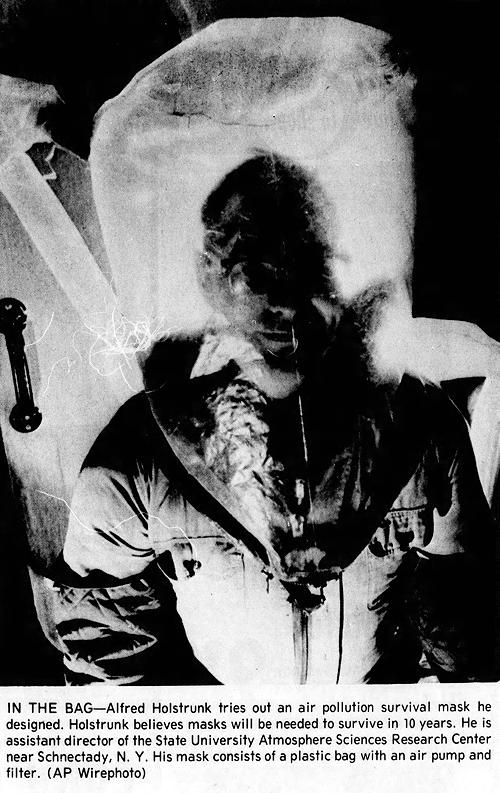
Corsicana Daily Sun - Dec 23, 1969
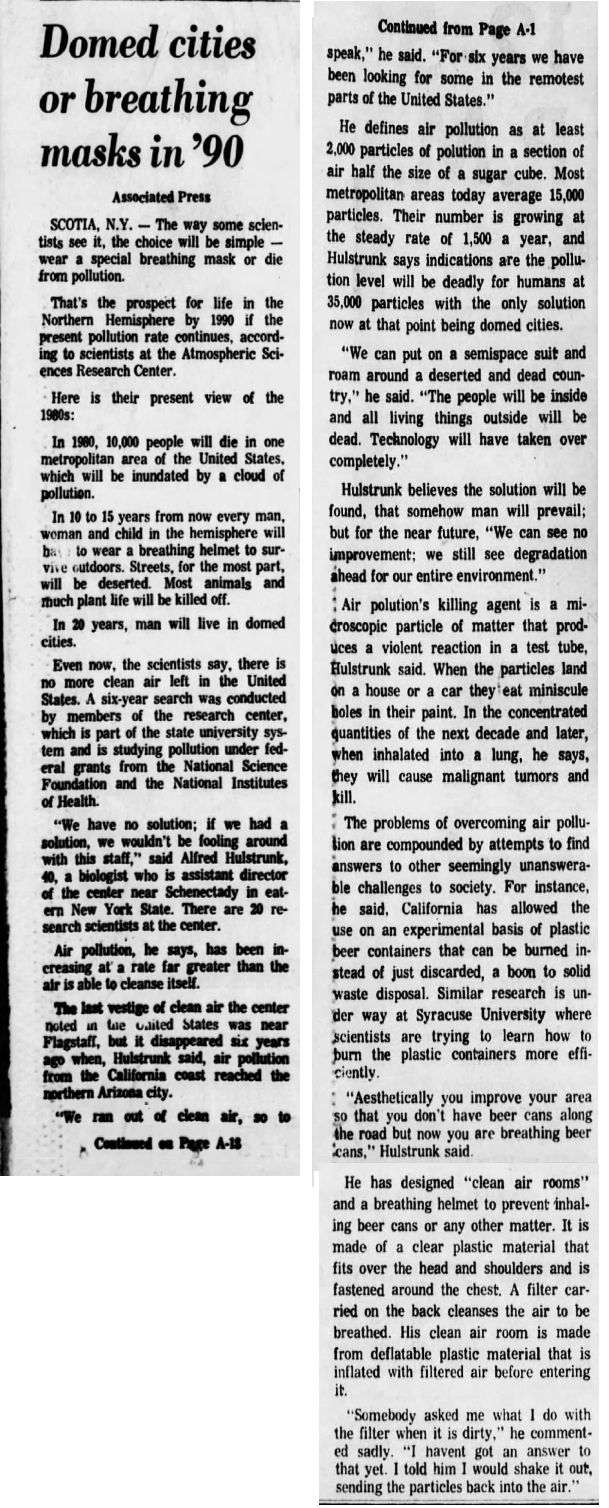
Arizona Republic - Dec 21, 1969
Note: It looks like Hulstrunk is still around, now aged 90. He recently gave a talk at Cedars of Lebanon State Park.
Posted By: Alex - Mon Aug 08, 2016 -
Comments (8)
Category: Predictions, Yesterday’s Tomorrows, Science, 1960s
Central Premonitions Registry
The Central Premonitions Registry was established by Robert Nelson in New York in 1968 (following the establishment of a similar agency in the UK the year before). It provided a place where people could send in premonitions or predictions about the future. These would then be filed away for future reference, to see if they came true.The Registry claimed to have a three-fold purpose: to identify people with genuine psychic gifts, to see how many premonitions actually came true, and also to serve as a warning system to prevent disaster in case they received "a flux of dreams that seem to refer to the same pending event."
As far as I know, the Registry never actually gave a heads-up about any looming disaster.
Eventually the Registry made its way online, but its website was abandoned around 2008. A copy of it is preserved in the Wayback Machine.

Cincinnati Enquirer - Mar 18, 1973
Posted By: Alex - Sun May 29, 2016 -
Comments (1)
Category: Predictions, 1960s
Frances Baskerville - The Singing Psychic
Frances Baskerville (1944-2009) of Dallas, Texas was involved in an accident in which an 18-wheel lumber truck backed into her car, while she was waiting outside a beauty parlor. The lumber crashed through the roof of the car, almost killing her. But it also caused her to have an out-of-body experience, and after that experience, she said, she had psychic abilities.Being a country-and-western fan, she chose to sing her predictions. For instance, in 1997 she appeared on the Howard Stern show where she sang her premonition that Patrick McNeill, who had disappeared outside a Manhattan bar, would be found 100 yards from his home in Port Chester, NY. (His body was eventually found floating near in pier in Brooklyn.)
Arthur Lyons and Marcello Truzzi gave this info about her in their book The Blue Sense: Psychic Detectives and Crime (1991):
Baskerville released an album, Songs From the Beyond. You can listen to the full album at the WFMU blog. One song from that album is below. And elsewhere on the web, you can listen to an interview with Baskerville from when she appeared on the Judy Joy Jones Show.

Posted By: Alex - Thu May 05, 2016 -
Comments (6)
Category: Music, Predictions
Baby’s burps predict his future
Back in 1964, Dr. Milton Berger called attention to the predictive power of a baby's burps. A baby with "strong and clear" burps will grow up to be a leader. However, the majority of people are "dithering" burpers. They'll become your run-of-the-mill member of the faceless masses.Odd theory, but probably as good a predictor of future success as anything.
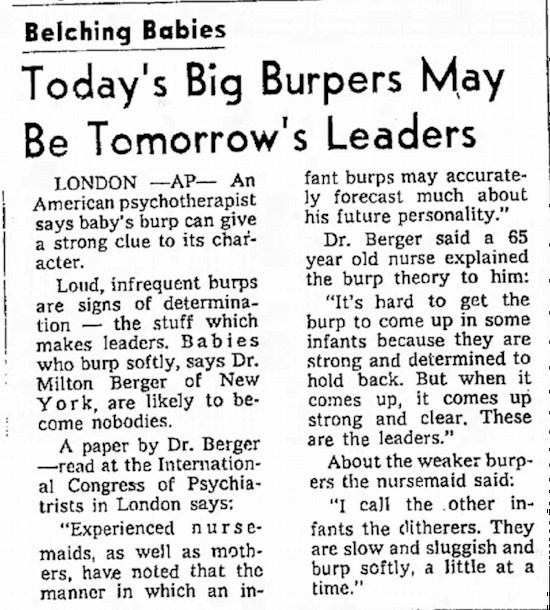
The Fresno Bee - Aug 21, 1964
Posted By: Alex - Sat Feb 20, 2016 -
Comments (5)
Category: Babies, Predictions, Babies and Toddlers, 1960s
Predictions for 2016 from 1966
In 1966, Margaret Thorne, a member of the Junior Historian Club of Woodrow Wilson High School in Beckley, West Virginia, published some predictions for the year 2016 in her local paper. Here's what she envisioned for the year we've now arrived at:The growth of suburbia: "the only land untouched by suburbia will be the national and state parks and forests, that our ancestors were foresighted enough to conserve and a few farms of enormous size in the midwest."
Work: "the vast majority of the people will be seated in front of man's ingenious invention, the computer."
Food: "People will take a pill for breakfast that will supply them with needed nourishment. Algae, a very simple plant, which can be grown in great vats and will multiply rapidly, can be made into very appetizing morsels."
Fuel: "More sources of fuels must be found and methods for bringing the natural resources to the surface. Someone must find ways to captivate the sun's radiation and make it work for us. The sun will need to be our major fuel in the years to come."
Water: "Our water supply will need to be taken from the seas as our lands get drier and drier."
Not bad, all in all. The food-in-pills and ubiquitous spread of suburbia were misses. But she scored on the increasing importance of computers, and she kind of anticipated the development of fracking and growth of solar technology, as well as the water scarcity (which is certainly true here in California).

The Raleigh Register — Apr 25, 1966
Posted By: Alex - Fri Jan 01, 2016 -
Comments (5)
Category: Predictions, Yesterday’s Tomorrows, 1960s
Life & Death Quiz

Take the Ubble UK Longevity Quiz and see how you score mortality wise over the next five years. Share results in extended if you'd like.
Posted By: Alex - Thu Jun 04, 2015 -
Comments (15)
Category: Death, Predictions, Quizzes

| Who We Are |
|---|
| Alex Boese Alex is the creator and curator of the Museum of Hoaxes. He's also the author of various weird, non-fiction, science-themed books such as Elephants on Acid and Psychedelic Apes. Paul Di Filippo Paul has been paid to put weird ideas into fictional form for over thirty years, in his career as a noted science fiction writer. He has recently begun blogging on many curious topics with three fellow writers at The Inferior 4+1. Contact Us |




